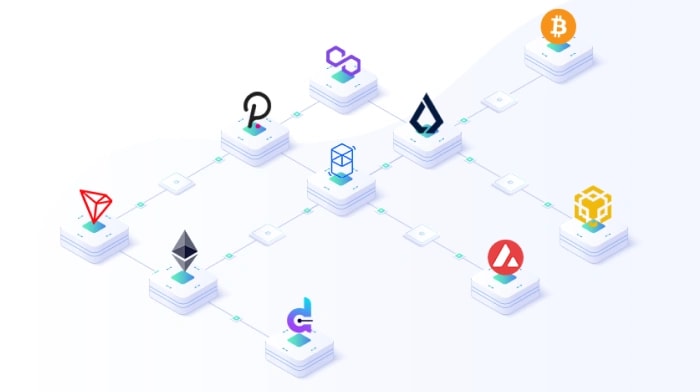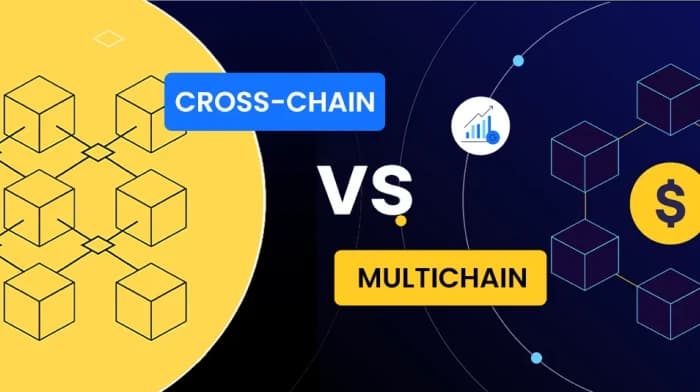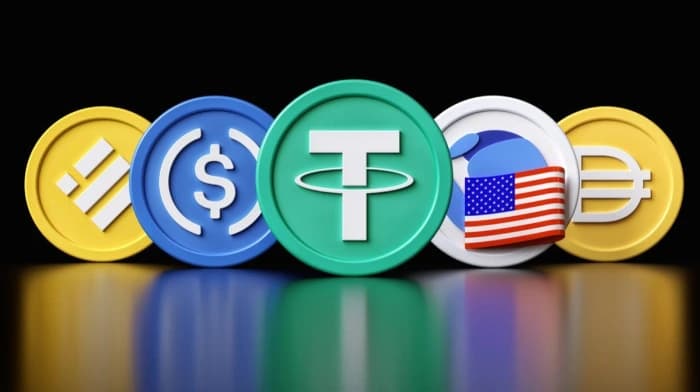
Introduction
The world of Web3 is exploding, with decentralized apps popping up over the place spread across blockchains and Layer 2 solutions. Each one has its way of keeping things secure and trustworthy.
As a result being able to work across chains has become really important since 2021 when cross chain protocols first appeared. Lately we've seen how crucial this technology is. With different blockchains and solutions out there finding ways for them to communicate and work together is key. This is where cross chain bridges and platform solutions come in. They're essential for making sure everything runs smoothly and that these different chains can talk to each other.
Wormhole, a player in chain messaging has helped move more than $39 billion in tokens and hit a milestone of $1 billion in messages sent between chains. Similarly Axelar has seen gains with the number of users soaring 430% and transactions between chains shooting up 478% over the past year.
What is Blockchain Interoperability?
Because blockchains aren't set up to talk to each other on their own being able to share information across chains is crucial to getting the most out of a system with blockchains. This is what's often called blockchain interoperability.
Blockchains can't talk to each other on their own so we need a way to get them to communicate. That's where cross chain messaging protocols come in. They're like a messenger that lets smart contracts share information across blockchain networks. This is really important for Web3 because it lets us move tokens and data around securely.
Understanding Cross-Chain Bridges
When we're talking about getting data from one blockchain to another we use something called chain bridges. These are basically programs that make it possible to send stuff like Bitcoin, NFTs or DeFi assets between blockchain networks. They're a part of making Blockchain ecosystems work because without them we couldn't move any of these assets around.
Cross chain bridges are revolutionizing the landscape by allowing transactions between networks effectively creating a vast and interconnected web of digital assets. Despite this many digital assets are still anchored to their blockchains. The benefits of chain bridges are numerous giving rise to a plethora of innovative activities.
However this increased interconnectedness also introduces a set of security concerns as hackers often set their sights on these programs seeking to exploit any weaknesses they may find.
Types of Cross-Chain Bridges
These things can be a bit finicky. It's probably an idea to have a solid grasp of how they work before using them. There are basically three kinds of bridges that let you move stuff between chains:
Lock and Mint
One type is called Lock and Mint. It's like an IOU. When you want to move tokens from one chain to another you essentially lock them up in a contract on the chain and then identical tokens are created on the chain you're sending them to.
To get the coins back on the source chain the process is essentially reversed by destroying or burning the wrapped tokens. There are a couple of ways this can work:
- Users can burn their tokens on the source chain. Then the same type of coins will be reissued or minted on the destination chain. This way the same native tokens are essentially transferred from one chain to another.
- Lock the tokens on the source chain, which then allows users to unlock an amount of tokens from a pool of coins on the destination chain. This method is a bit more indirect but gets the job done.
Revenue Sharing Model
Bridges often work by sharing revenue between parties, which helps to attract funds from both sides. Once a bridge has done its job it can also be used for things like letting tokens be swapped, lent or staked on the new chain all as part of the same transaction. This can even include depositing tokens into contracts on the chain.
Notable Cross-Chain Bridges
Before choosing a chain bridge it's essential to check if it supports your particular blockchain network, coin or NFT. Fees can also vary greatly between networks and are subject to changes. With that in mind here are some notable cross chain bridges worth considering:
Celer cBridge
This platform enables the transfer of liquidity across blockchains, thanks to its Celer State Guardian Network. The list of supported networks is quite extensive featuring names like:
- Boba Network
- Heco
- Clover
- Moonbeam
- Shiden
- Aurora
- Polygon
The list of supported cryptocurrency tokens is pretty extensive featuring names like Binance USD, Dodo, Unified Society and Lyra.
Portal Token Bridge
The Portal Token Bridge is a component allowing for transfers of tokens and NFTs between different blockchain chains. It's powered by the Wormhole protocol, which provides a foundation for these transfers. A range of blockchain networks are compatible including:
- Acala
- Fantom
- Aurora
- Various smart chains
Some of the tokens that can be transferred via this bridge include Tether, Frax Protocol Token, The Sandbox and Uniswap.
Synapse Bridge
Then there's the Synapse Bridge, built on the Synapse Protocol. This protocol focuses on enabling universal chain communication essentially allowing different chains to talk to each other in a secure environment.
A range of blockchain networks are supported, including:
- Ethereum
- Cronos
- Optimism
- Polygon
- Boba Network
- Moonriver
MultiChain
MultiChain, previously known as Fantom Anyswap operates as a chain router. This technology allows for the transfer of assets and data between blockchain networks. What sets it apart is its support for a range of types something that's not typically seen in other cross chain bridging services.
How Cross-Chain Bridges Work
Cross chain bridge platforms play a role in the ecosystem enabling blockchain networks to communicate with each other smoothly. This is essential for the function of these networks allowing them to work together efficiently.
These platforms break down the barriers between systems allowing them to share information and assets between blockchains. Some key features of chain bridge platforms are:
- They make it possible to do transactions between different blockchain networks
- They use cryptocurrency, digital assets and DeFi protocols
- They can be vulnerable to security risks like hacking
The Technical Process
Basically when you want to move something from one blockchain to another the bridge platform destroys the tokens on the blockchain and creates a kind of copy on the new network. This copy, often called a "wrapped" token represents the asset and can be turned back into it or exchanged for something else.
When it comes to moving assets and data between blockchain platforms the process can be tailored to fit needs by using a range of:
- Decentralized protocols
- Validators
- Smart contracts
Key Components
Bridging Mechanism
One key part of this process is the bridging mechanism. This is typically handled by chain bridge platforms that use a combination of oracles, smart contracts and other tools to make it possible to transfer assets and data between different blockchains.
Native Tokens
The tokens used on these bridges also play a role. They're often used as:
- Collateral to secure the bridge
- Ensure that transactions are valid
- Represent the value being transferred
In words these native tokens are essential for making sure that bridges work smoothly and that transactions are secure.
Consensus Mechanisms
Cross chain bridge development relies on consensus mechanisms to verify transactions across networks. This is often achieved through methods like:
- Signature wallets
- Threshold signatures
Which help ensure the legitimacy of transactions as they move between chains.
Relayers and Validators
Relayers and validators play a role in this process. These are the entities for:
- Validating transactions
- Ensuring that all involved networks are in agreement
They can take the form of third party validators or independent organizations that are paid for their services.
Decentralized Oracles
Some of the cross chain bridge platforms make use of decentralized oracles. These allow the platform to fetch real time data from sources outside the blockchain or from blockchain networks. This enables the transfer of data or assets across chains making the whole process more flexible and powerful.
Security and Governance
When assets are transferred between blockchain platforms using interoperability solutions they often need to be locked on the chain and then unlocked on the destination chain. This is done to keep the process secure and make sure everything runs smoothly.
Governance models can be built into the development of chain bridge solutions. These models allow participants to vote on proposals that determine how the bridge works.
Because cross chain bridges are a target for hackers they need to have security measures in place like regular audits to establish trust and credibility.
User Experience and Platform Development
User Interface Design
When it comes to moving assets between blockchains people work directly with chain bridge platforms. For these platforms to be useful the companies that develop them need to create interfaces that are easy to use. This means making it simple for people to get the information they need like:
- Notifications
- Records of transactions
Community Benefits
Building a chain bridge platform can make a big difference. It helps groups of people who work with blockchains by making it easier for them to work together and for users to get involved. Different stakeholders in the blockchain world can benefit from having a chain bridge platform. It can help improve how different blockchains work together and make it easier for users to take part.
Use Cases and Applications
DeFi and dApp Projects
Expanding to networks can be a game changer for DeFi and dApp projects. By doing they can tap into an audience and make the most of different blockchain technologies. This move can help them grow and become more resilient.
Cross-Chain Swaps
Cross chain swaps are a part of this. They let users trade easily between blockchains, which makes for a smoother experience. Centralized and decentralized cryptocurrency exchanges have already caught on using chain swaps to facilitate seamless trading.
NFT Marketplaces
NFT marketplaces are also on board using these systems to let people buy and sell NFTs across networks. This not increases liquidity but also helps these marketplaces reach a wider audience.
Gaming Platforms
Gaming platforms can gain a lot from chain bridges. These bridges let users move their in-game assets from one network to another which makes for a exciting gaming experience.
Benefits of Cross-Chain Development
The advantages of developing these bridges go beyond the tech itself. There are some benefits for users:
Increased Liquidity
Cross chain bridges make it easier for people to buy and sell assets. This increases liquidity, which's a deal. It means that users can now access and use their cryptocurrency holdings in different ways since they can exchange assets between blockchain networks.
When a token is useful in ways it helps the DeFi economy grow. This is also true when there's liquidity across chains as it removes obstacles that can hold the economy back.
Multiple Ecosystem Access
Having multiple ecosystems available is also a plus. Cross chain bridges act like doorways to blockchain worlds letting users interact with environments and opening up possibilities for decentralized apps to run on multiple chains. This makes the overall experience better for users and brings Web3 environments together allowing people to tap into the distinct strengths of different blockchain platforms.
Cost and Speed Optimization
The advantages of chain bridges go beyond just connecting different networks. They also offer a way to make transactions faster and more cost effective. By allowing for the adoption of blockchains and eliminating the need for exchanges bridges can speed up the whole process. This in turn can help distribute the load of transactions and get things processed quicker.
For example bridges that work with Ethereum's scaling solutions can provide an affordable option for users who would otherwise have to use the expensive Ethereum mainnet.
Risk Diversification
One major benefit of these bridges is that they help reduce the risks that come with relying on one chain. By making it possible to allocate and diversify assets across blockchain platforms users can spread out their risks and avoid putting all their eggs in one basket.
When a blockchain network goes down it's good to have your assets spread out across chains. This way if one network is disrupted you can still access your assets on another. It's not uncommon for these types of disruptions to happen on blockchain networks.
Technical Mechanisms
To counter this developers have come up with ways to move assets and data between blockchain systems. This makes it possible for different blockchain networks to work together seamlessly. There are a few mechanisms that make this possible:
Atomic Swaps
For one there are atomic swaps. This is a way for people to trade cryptocurrencies from blockchains without needing a middleman. It's a principle and it's an important one. It allows for the free exchange of assets between different blockchain networks, which is essential for making blockchains more useful and scalable.
This process eliminates the risk of one transaction going through while the other doesn't by making sure that either both happen or neither does. The way this works is by using something called smart contracts. These are also known as Hash Time Locked Contracts or HTLCs for short. They use math problems to lock in a transaction until certain conditions are met within a set time frame. Think of it like a safe. The money is frozen until both parties do what they're supposed to which makes the whole thing a lot more secure.
Relay Chains
There's another tool that helps make transactions between blockchains and that's relay chains. Essentially they act as a kind of bridge between two chains allowing certain platforms to operate across chains at once.
Blockchains are typically isolated but some designs allow them to talk to each other. This is where cross network chains come in. They oversee networks making it possible for them to communicate and validate transactions with one another. The benefit of this setup is that each blockchain remains intact. Assets can still be easily transferred between them.
Sidechains
Sometimes blockchains have chains that can facilitate asset transfers between those chains and main blockchains. This is known as a sidechain. It's useful because it enables blockchains to be more scalable and allows for experimentation without flooding the network. Sidechains can be tailored to tasks, which increases their usefulness.
Impact on Blockchain Ecosystem
The creation of chain bridges is changing the way blockchains work together. For a while the blockchain ecosystem has faced problems like:
- Security risks
- Complexity
- Limited options
- Compatibility issues
Cross chain bridges are now tackling these problems head on. They are making blockchains more secure, easier to use and more diverse while also allowing them to work better together. One key effect of chain bridges is that they are opening up a whole new world of possibilities for blockchain technology.
Portfolio Diversification
Diversification is key when it comes to managing risk in the world of cryptocurrency. That's where cross chain bridges come in. They let users spread their distributed ledger portfolios across blockchain ecosystems. This way it's not about being stuck in one ecosystem. Rather having the freedom to explore different tokens and DeFi opportunities on various chains.
By doing investors can reduce their exposure to risk by picking and choosing the benefits of each blockchain. For instance some blockchains offer fees or faster transaction speeds, which can be a plus. It's all about mixing and matching to find the fit.
Enhanced Interoperability
Then there's the issue of interoperability. Cross chain bridges basically act as a messenger between blockchain networks allowing them to communicate and transfer assets with ease. This opens up a world of possibilities where different blockchains can work together seamlessly.
For DeFi platforms to really take off they need to be able to work with each other. This means users should be able to move their assets between platforms without any hassle. One big advantage of this is that it lets users tap into Bitcoin's liquidity making their assets more useful.
User Experience Simplification
Simplifying things is a part of this. Cross chain bridges make life easier for users by taking the hassle of dealing with lots of assets. Of having to juggle wallets and interfaces for each blockchain users can just stick with one simple interface that hides all the complicated stuff underneath. This makes it way easier for people to get involved and use cryptocurrencies for those who're new to the scene and might be put off by all the technical complexity.
Security Features
Safety is a priority when it comes to transactions on chain blockchain platforms. To protect users during asset transfers these bridges have been designed with security features. By using contracts and cryptographic protocols cross chain bridges ensure that transactions are executed in an reliable manner. This focus on security helps build trust among users allowing them to participate in chain activities without worrying about fraud or losing their assets.
Common Questions
What is a blockchain bridge exactly?
A blockchain bridge is a tool in the asset space serving as a connection between different blockchain networks. They make it possible to share and transfer data, assets and smart contracts between blockchain systems.
Why do we need blockchain interoperability platforms?
One of the issues with blockchain technology is that different networks can't always talk to each other. That's where blockchain interoperability platforms come in. These platforms are basically a way for different blockchain networks to interact and share information. This is an thing because it helps break down some of the barriers that are currently holding blockchain technology back.
When you can get blockchain networks talking to each other it opens up a lot of possibilities. For one thing it means that users can move their assets around easily. This is where cross chain bridges come in. These are decentralized tools that let users transfer stuff between blockchain networks.
Examples of Popular Platforms
Typically you'll find bridges in Web3 blockchains especially after Bitcoin and Ethereum set the stage. Base, Arbitrum, Avalanche and Polygon are some examples. Each with their token like ARB, AVAX and MATIC.
Streamlining transactions and fostering liquidity across platforms. That's the role of tools in the financial world. They basically make it easier to move money and access it from angles.
Popular Cross-Chain Bridge Examples
| Platform | Purpose | Networks Connected |
|---|---|---|
| Polkadot bridges | Connect blockchains creating a network where they can all communicate | Multiple blockchain networks |
| RenBridge | Transfer a range of assets to Ethereum | Multiple chains to Ethereum |
| Polygon Bridge | Links Ethereum and Polygon networks | Ethereum and Polygon |
Professional Development Services
For businesses looking to jump into the blockchain space it can be overwhelming. That's where professionals come in. Development companies that specialize in blockchain implementation. They work with clients to create solutions whether it's:
- Developing contracts
- Building custom apps on the blockchain
- Integrating blockchain services into existing systems
By doing they help companies overcome the hurdles and successfully make the transition to blockchain.


